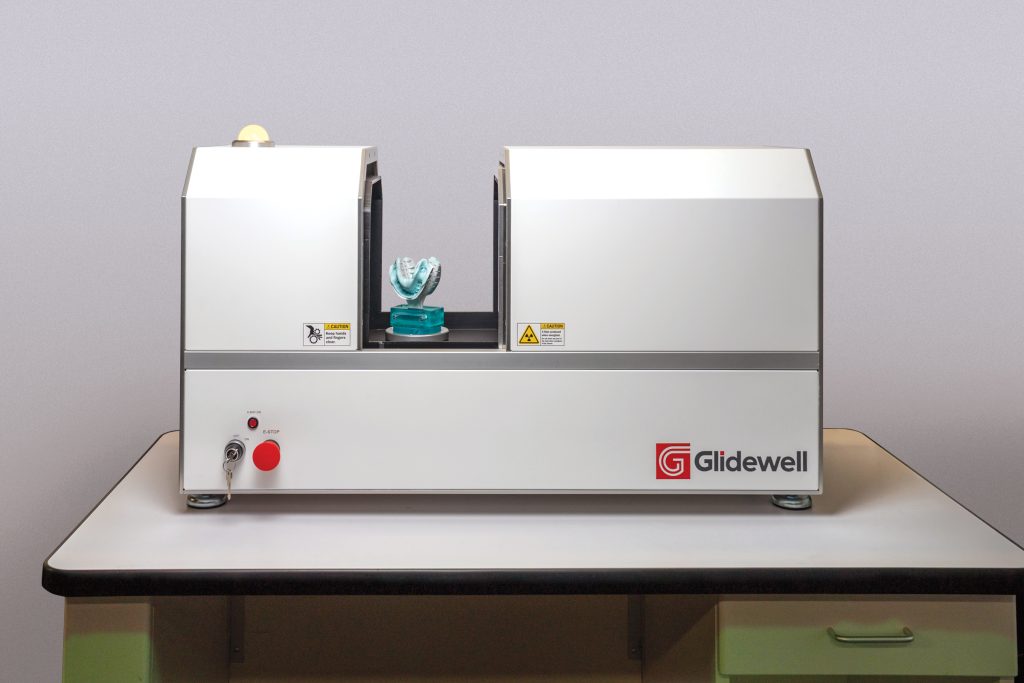It may seem unexpected for breakthroughs in CT scanning technology to come from a dental laboratory. But foresight is exactly what California-based Glidewell dental lab is known for. In a manufacturing field that requires as much volume as it does precision, the dental lab has developed scanners that strike the right balance of affordability, speed, size and precision, allowing them to scale up at any time as the market demands without taking on financial risk.
But why would a dental lab need computed tomography to optimize their production? At the beginning of the Industry 4.0 Revolution, Glidewell, the largest privately-owned dental laboratory in the U.S., initiated a unique workflow in which every case order submitted by dentists gets digitized via CT scanner and then perfected in a virtual environment. This proprietary system allows the production floor to churn out accurate dental products with fewer errors at a faster rate while applying AI-powered design software for greater precision and esthetics. However, they ran into a crucial problem: Finding a commercial CT scanner that could keep up with their high-volume workload.
Glidewell’s digital workflow necessitated modern technology in a field dominated by an artisan-like workforce of technicians and designers. Their initial exploration in digital scanning started with optical scanners. But the optical scanners could not capture the finer details present in dental impressions, nor could they reliably capture the angles and curves of natural dentition. This made it difficult to consistently fabricate accurate products that were fit for consumer acceptance.
Glidewell then tested multiple commercial scanners in order to find one that could meet their needs. But their experience with conventional industry scanners was one in the same: Breakdown after breakdown due to the constant cycling, expensive technology that stretched out their budget, and little room to scale up with the growing pace of the industry.
“The vast majority of available scanners were intended for university and research institutes, not use in a manufacturing environment,” said Glidewell Senior Vice President of Engineering, David Leeson. “Because of this, in addition to the available machinery being expensive to procure, it was also expensive to operate.”
It was during this process that the company realized that what they needed was far more unique than what the current market offered. They needed something with mass scanning capabilities, reduced repair costs, high-quality imaging and quick operating times. And it was at this point they thought: “Why not make one ourselves?”
The engineering team at Glidewell was primed to start working on something that better suited the company’s needs. Not only did the engineers thoroughly understand the technology because of the time they spent constantly repairing the previously used scanners, they also understood the dental industry as part of the leading dental lab in the U.S. As a team, they were up to the challenge. And as a company, they were eager for a chance to enter a whole new production space, making a Glidewell-shaped imprint in the Industry 4.0 Revolution.
What they came up with answered all three major pain points encountered with conventional industry scanners: cost, speed and size. By producing the scanners in-house, they were able to optimize the materials used during fabrication, allowing for a sense of customization with the scanner itself. This meant that they could modify the scanners to different specifications, allowing for greater versatility of just one machine instead of buying multiple for different purposes. The low price tag has also allowed the scanners to be scaled, enabling the company to amass an impressive fleet of scanners to support their production demands.

Secondly, the Glidewell scanners can scan with wicked speed. The scanning process itself can produce highly-detailed three-dimensional images at a resolution of 50 microns — a micron level that approaches the threshold of objects visible to the human eye, giving technicians a highly-detailed look at objects they would not be able to see otherwise — in just 30–60 seconds. However, the scanning speed is just one part of the whole time-saving process. The engineers had to take into account the cycling speed that became a constant battle with the conventional scanners. This led them to develop asynchronous meshing and reconstruction, which allows the production team to position and scan the next object while the first object is still being uploaded to Glidewell’s in-house cloud service, creating a smooth and constant cycle process.
Lastly, the scanners have a small physical footprint. Today, Glidewell has jam-packed their facilities with nearly 100 operational scanners. The ability to run so many scanners is key in supporting their high-volume workflow and keeping their customer-base satisfied.
“We solved a problem that was not just unique to us, but prevalent in other industries as well,” continued Leeson. “We wanted to use our resources to help other companies get over the high barrier of entry that CT scanning poses, democratizing a normally exclusive technology and improving the field of additive manufacturing as a whole.”
To stay up to date with the latest 3D printing news, don’t forget to subscribe to the 3D Printing Industry newsletter or follow us on Twitter or liking our page on Facebook.
While you’re here, why not subscribe to our Youtube channel? featuring discussion, debriefs, video shorts and webinar replays.Are you looking for a job in the additive manufacturing industry? Visit 3D Printing Jobs for a selection of roles in the industry.



